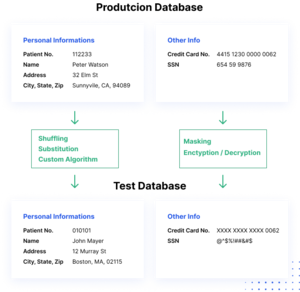Data Masking
Data Masking is a way to create a fake, but a realistic version of your organizational data. The goal is to protect sensitive data, while providing a functional alternative when real data is not needed—for example, in user training, sales demos, or software testing.
Data masking processes change the values of the data while using the same format. The goal is to create a version that cannot be deciphered or reverse engineered. There are several ways to alter the data, including character shuffling, word or character substitution, and encryption.[1]
Background of Data Masking[2]
Data involved in any data masking or obfuscation must remain meaningful at several levels:
- The data must remain meaningful for the application logic. For example, if elements of addresses are to be obfuscated and city and suburbs are replaced with substitute cities or suburbs, then, if within the application there is a feature that validates postcode or post code lookup, that function must still be allowed to operate without error and operate as expected. The same is also true for credit-card algorithm validation checks and Social Security Number validations.
- The data must undergo enough changes so that it is not obvious that the masked data is from a source of production data. For example, it may be common knowledge in an organization that there are 10 senior managers all earning in excess of $300K. If a test environment of the organisation's HR System also includes 10 identities in the same earning-bracket, then other information could be pieced together to reverse-engineer a real-life identity. Theoretically, if the data is obviously masked or obfuscated, then it would be reasonable for someone intending a data breach to assume that they could reverse engineer identity-data if they had some degree of knowledge of the identities in the production data-set. Accordingly, data obfuscation or masking of a data-set applies in such a manner as to ensure that identity and sensitive data records are protected - not just the individual data elements in discrete fields and tables.
- The masked values may be required to be consistent across multiple databases within an organization when the databases each contain the specific data element being masked. Applications may initially access one database and later access another one to retrieve related information where the foreign key has been masked (e.g. a call center application first brings up data from a customer master database and, depending on the situation, subsequently accesses one of several other databases with very different financial products.) This requires that the masking applied is repeatable (the same input value to the masking algorithm always yields the same output value) but not able to be reverse engineered to get back to the original value. Additional constraints as mentioned in (1) above may also apply depending on the data element(s) involved. Where different character sets are used across the databases that need to connect in this scenario, a scheme of converting the original values to a common representation will need to be applied, either by the masking algorithm itself or prior to invoking said algorithm.

